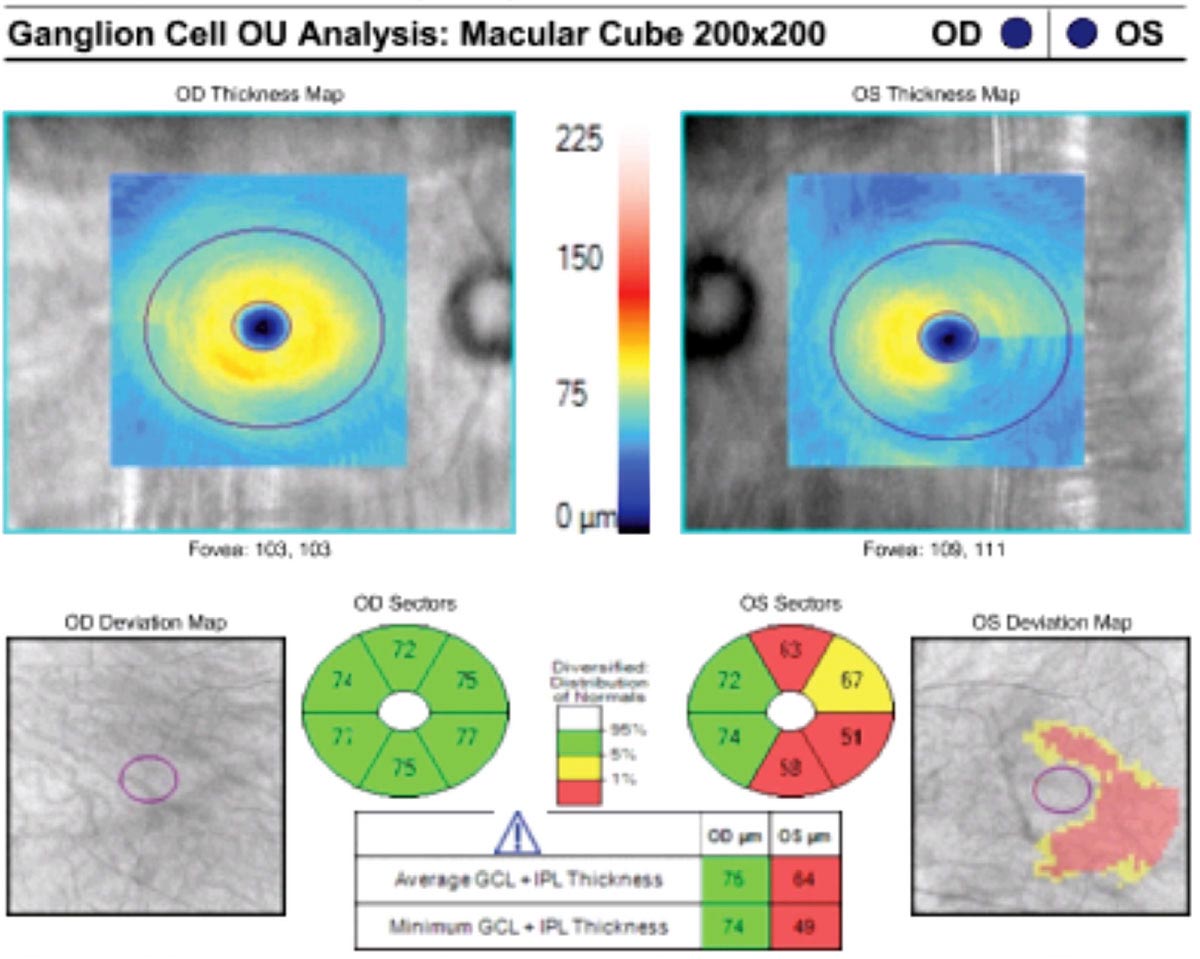 |
| ALOE allele carriers may be more susceptible to neuroretinal thinning. Photo: Bisant Labib, OD. Click image to enlarge. |
Like primary open-angle glaucoma (POAG), diseases that bring on symptoms of dementia—including Alzheimer’s, frontotemporal dementia and Lewy body disease—result from progressive loss of neurons within the central nervous system, both generally and within the retina. However, due to conflicting data from other studies investigating genetic associations between POAG and dementia, the exact nature of this association remains unclear. The most commonly investigated genetic parameter in these studies is apolipoprotein E (APOE), the principal genetic determinant of Alzheimer’s disease, Lewy body disease and all-cause dementia.
A recent study investigated the association between POAG and the genetic risk of dementia by investigating associations between the APOE E4 allele and structural markers of neuroretinal thinning relevant to glaucoma progression. The APOE E4 allele was associated with faster rates of macular ganglion cell/inner plexiform layer (mGCIPL) thinning, particularly in normal-tension glaucoma (NTG) eyes.
The study included all available eyes from participants recruited to the Progression Risk Of Glaucoma: Relevant SNPs with Significant Association (PROGRESSA) study with genotyping data from which APOE genotypes could be determined. The researchers measured longitudinal rates of thinning in the mGCIPL and the peripapillary retinal nerve fiber layer (pRNFL). Longitudinal analysis of mGCIPL change included 1,446 eyes from 760 participants, and longitudinal analysis of the pRNFL included 1,638 eyes from 853 participants.
APOE alleles and genotypes were determined in PROGRESSA, and their distributions were compared with an age- and race-matched normative cohort, the Blue Mountains Eye Study. Structural parameters of neuroretinal atrophy measured using spectral-domain OCT were compared within the PROGRESSA cohort on the basis of APOE E4 allele status.
Rates of mGCIPL thinning were faster in participants carrying one or more copies of the APOE E4 allele (β coefficient=-0.13μm/year), and this was strongest in eyes affected by NTG (β coefficient=-0.20μm/year). APOE E4 allele carriers were also more likely to be lost to follow-up and demonstrated a thinner average mGCIPL (70.9μm vs. 71.9μm) and pRNFL (77.6μm vs. 79.2μm) after a minimum of three years of monitoring. The researchers believe their results suggest the APOE E4 allele may be a risk factor for retinal ganglion cell degeneration in glaucoma.
Although they were able to demonstrate that faster rates of APOE E4-associated mGCIPL thinning seen in NTG eyes were not seen in controls, the researchers noted that these eyes belonged to individuals recruited as glaucoma suspects. Also, the mechanisms by which mGCIPL thinning may occur in individuals carrying the APOE E4 allele remain unclear.
“As genome-wide association study data has not identified glaucoma-associated risk variants within the APOE gene, the relevance of APOE E4-associated mGCIPL thinning to glaucoma and its visual outcome remains uncertain,” the authors concluded in their paper. “Subsequent replication studies within separate cohorts will help to validate and elucidate the relationship between the APOE E4 allele and glaucoma."
Mullany S, Marshall H, Diaz-Torres S, et al. The APOE E4 allele is associated with faster rates of neuroretinal thinning in a prospective cohort study of suspect and early glaucoma. Ophthlamol Sci. April 19, 2022. [Epub ahead of print].

